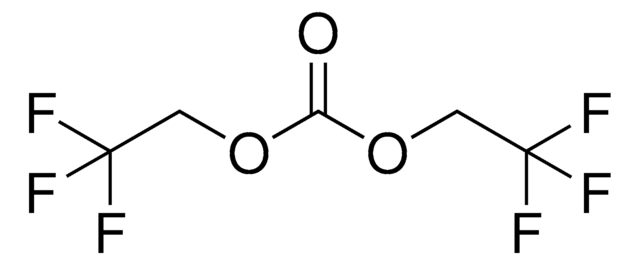917060
1 M Biphenyl in DME
a precursor solution to prepare the prelithiation/presodiation reagent for disordered carbon, SiO, Sn, Sb, P, and S electrodes
Autenticatiper visualizzare i prezzi riservati alla tua organizzazione & contrattuali
About This Item
Formula empirica (notazione di Hill):
C12H10
Peso molecolare:
154.21
Numero MDL:
Codice UNSPSC:
12352401
NACRES:
NA.23
Prodotti consigliati
Livello qualitativo
Forma fisica
liquid
Concentrazione
1 M
applicazioni
battery manufacturing
Temperatura di conservazione
2-8°C
Applicazioni
This product is biphenyl (Bp) solution in anhydrous DME (1 mol/L) is a precursor reagent that could be easily handled to prepare prelithiation or presodiation reagent. By direct reaction of Li metal, it forms a strong reducing reagent of Li-Bp. The resulting Li-Bp/DME reagent is applicable to prelithiate most of the active materials for Li ion batteries, such as Sn, Sb, P, S, SiO and other metal oxide. On the other hand, a presodiation reagent can be prepared by reacting Bp/DME solution with Na metal. Na-Bp/DME reagent can be used to presodiate hard carbon, a promising anode material in Na ion batteries.
Nota sulla preparazione
Suggested Directions for use:
To prepare 1 M Li-Bp/DME reagent, > 0.07 g of Li metal is added into every 10 ml of 1 M BP/DME solution.
To prepare 1 M Na-Bp/DME reagent, > 0.23 g of Na metal is added into every 10 ml of 1 M BP/DME solution.
- Step 1 Preparation of Prelithiation/presodiation reagent
To prepare 1 M Li-Bp/DME reagent, > 0.07 g of Li metal is added into every 10 ml of 1 M BP/DME solution.
To prepare 1 M Na-Bp/DME reagent, > 0.23 g of Na metal is added into every 10 ml of 1 M BP/DME solution.
- Step 2 Prelithiation/presodiation of electrodes
Avvertenze
Danger
Indicazioni di pericolo
Classi di pericolo
Acute Tox. 4 Inhalation - Aquatic Chronic 2 - Eye Irrit. 2 - Flam. Liq. 2 - Repr. 1B - Skin Irrit. 2 - STOT SE 3
Organi bersaglio
Respiratory system
Rischi supp
Codice della classe di stoccaggio
3 - Flammable liquids
Classe di pericolosità dell'acqua (WGK)
WGK 2
Punto d’infiammabilità (°F)
33.8 °F
Punto d’infiammabilità (°C)
1 °C
Certificati d'analisi (COA)
Cerca il Certificati d'analisi (COA) digitando il numero di lotto/batch corrispondente. I numeri di lotto o di batch sono stampati sull'etichetta dei prodotti dopo la parola ‘Lotto’ o ‘Batch’.
Possiedi già questo prodotto?
I documenti relativi ai prodotti acquistati recentemente sono disponibili nell’Archivio dei documenti.
Gongwei Wang et al.
ACS applied materials & interfaces, 11(9), 8699-8703 (2019-02-20)
This study reports an ambient-air-tolerant approach for negative electrode prelithiation by using 1 M lithium-biphenyl (Li-Bp)/tetrahydrofuran (THF) solution as the prelithiation reagent. Key to this strategy are the relatively stable nature of 1 M Li-Bp/THF in ambient air and the
High performance lithium-ion and lithium−sulfur batteries using prelithiated phosphorus/carbon composite anode..
Wang F, et al.
Energy Storage Materials, 24, 147-152 (2020)
High performance lithium-ion and lithium?sulfur batteries using prelithiated phosphorus/carbon composite anode.
Wang G, et al.
Energy Storage Materials, 24, 147-152 (2020)
Il team dei nostri ricercatori vanta grande esperienza in tutte le aree della ricerca quali Life Science, scienza dei materiali, sintesi chimica, cromatografia, discipline analitiche, ecc..
Contatta l'Assistenza Tecnica.











